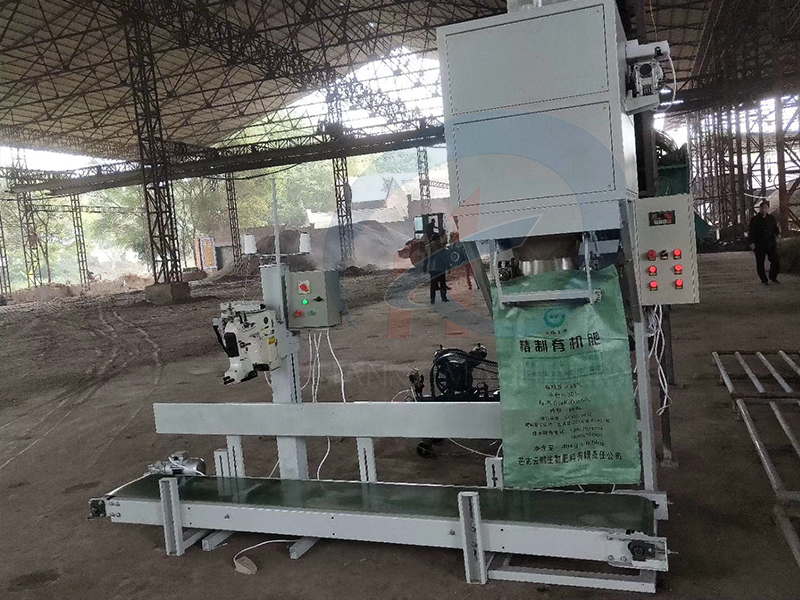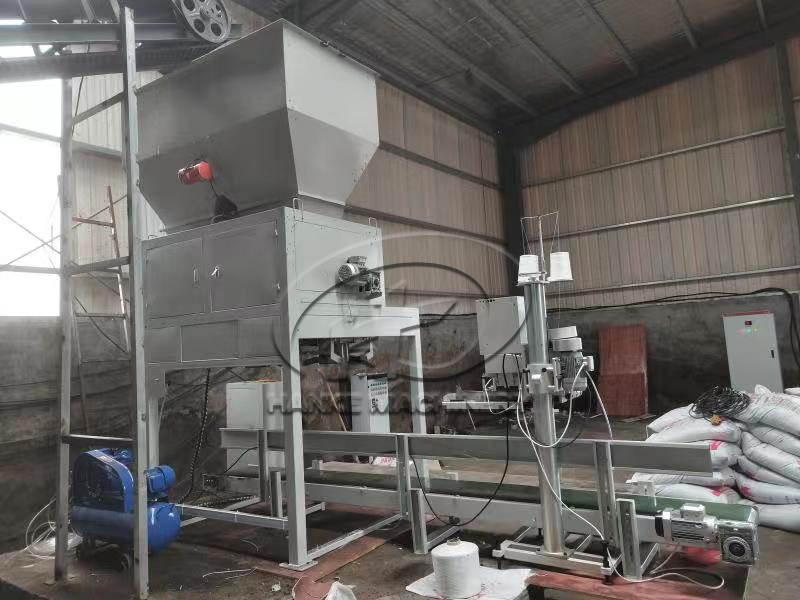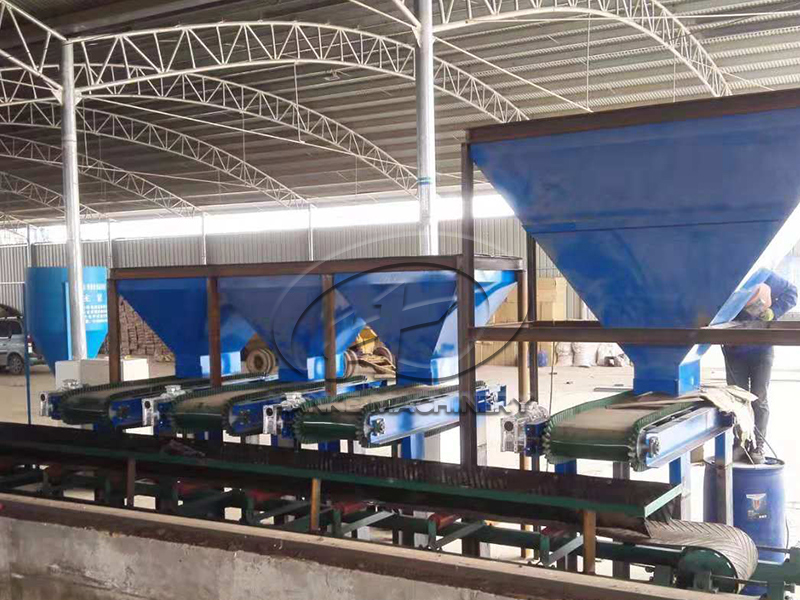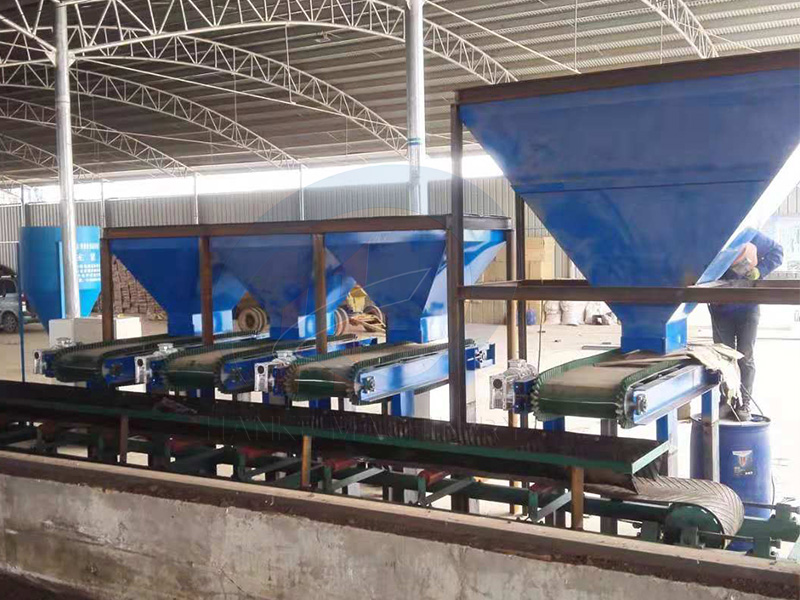 HOME > News > Industry News > Which components of the dynamic batching machine for bio-bacterial fertilizer need special protectio
HOME > News > Industry News > Which components of the dynamic batching machine for bio-bacterial fertilizer need special protectio Update time : 2025-09-01 Publisher:Zhengzhou Hanke Machinery
The core function of the dynamic batching machine for biological bacterial fertilizer is to achieve precise dynamic proportioning of raw materials for bacterial fertilizer (such as bacterial agents, organic matter, carriers, etc.). The particularity of biological bacterial fertilizer (sensitivity of bacterial agent activity, some raw materials are prone to moisture absorption and caking, and contain fine particle impurities) determines that the key components need to be protected with emphasis to avoid equipment failure, decline in proportioning accuracy or damage to the activity of bacterial agents. The following are the key components that need to be protected with emphasis and specific protective measures:
I. Core metering components: Ensure accurate proportioning to prevent waste / inactivation of microbial agents
The metering accuracy of the dynamic batching machine directly determines the quality of the bacterial fertilizer product. Moreover, most of the metering components are precision structures that are easily affected by the characteristics of the raw materials, so they need to be given priority protection.
1.Weighing sensor (or metering screw / belt scale)
Core risks:
The raw materials of biological bacterial fertilizer (such as humic acid carriers, bacterial agent powders) may contain fine impurities (stones, fibers). Long-term friction can wear out the sensor. If the raw materials absorb moisture and form lumps, it will cause material accumulation and pressure on the sensor, resulting in measurement drift or hardware damage.
Protective measures:
Raw material pretreatment: Configure a vibrating screen + magnetic separation device to filter out impurities and metal particles in advance to prevent them from entering the metering system.
Regular calibration: Calibrate the sensor with standard weights every week (or every 50 hours of operation) to ensure the accuracy is within ±0.2% (the precision requirement for microbial fertilizer blending is relatively high, especially when the proportion of microbial agents is low, as errors can easily lead to insufficient activity).
Moisture-proof protection: Install moisture-proof fans or dehumidification modules in the sensor installation area to prevent moisture from causing sensor circuit failures; regularly blow dry compressed air on the sensor surface to remove residual powder.
2. Metering screw / scraper (dynamic conveying metering component)
Core risks:
The raw materials of bio-fertilizer (such as bacterial agent granules and organic matter powder) are prone to adhering to the surface of the screw or scraper. Long-term accumulation can lead to "bridging" (material blockage), or unstable conveying volume due to wear. If the raw materials contain corrosive components (such as some organic acid carriers), it will also accelerate the rusting of the screw.
Protective measures:
Material selection: Prioritize the use of 304 stainless steel or wear-resistant coatings (such as Teflon) for screws / scrapers, which are anti-adhesive and anti-corrosive.
Regular cleaning: After each shutdown, use compressed air (low pressure, to avoid blowing away the microbial agent) or a soft brush to clean the residual material on the screw / scraper. Disassemble and inspect once a week to remove stubborn adherents.
Lubrication and maintenance: For transmission parts such as screw bearings, use food-grade lubricating grease (to avoid contaminating the bacterial fertilizer), and replenish it once a month to prevent dry grinding wear.

II. Conveying and Mixing Components: Prevent material blockage and protect the activity of microbial agents.
The conveying and mixing sections of the dynamic batching machine come into direct contact with the raw materials of the bacterial fertilizer, and thus need to guard against two major issues: "blockage" and "destruction of the activity of the bacterial agent".
1.Material conveying pipeline / chute
Core risks:
The raw materials of bio-organic fertilizer (especially those with high moisture content carriers) are prone to adhere and form lumps on the inner walls of pipelines, causing "material blockage" and affecting the conveying efficiency. If the pipeline angles are not reasonable (such as too small inclination), it will further aggravate the accumulation of materials and even damage the downstream components.
Protective measures:
Structural optimization: The inner walls of the pipes are polished (to reduce adhesion), the chute inclination angle is designed to be ≥ 60° (to prevent material retention), and vibrators are installed at key positions (such as pipe turns) (with high frequency and low amplitude to prevent blockage accumulation).
Real-time monitoring: Install blockage sensors (such as capacitive or ultrasonic types) at locations prone to blockage. Once a blockage is detected, the equipment will automatically shut down and issue an alarm to prevent hard blockage and damage to the pipeline.
Regular cleaning: Use high-pressure air (or a dedicated cleaning rod made of soft material) to clear the pipes every week to prevent the formation of hard lumps that are difficult to clean.
2. Dynamic mixing bin (if with mixing function)
Core risks:
If the stirring blades in the mixing tank are worn or unbalanced, it will lead to uneven mixing (uneven distribution of microbial agents, affecting product quality); if the residual materials in the tank become moldy (especially in a humid environment), it will contaminate the new raw materials and destroy the activity of the microbial agents.
Protective measures:
Blade maintenance: Check the wear of the stirring blades monthly. If there are notches or deformations on the blade edges, replace them promptly (to avoid a decline in mixing efficiency); Regularly tighten the connecting bolts of the blades (to prevent them from falling off during high-speed rotation).
Cleaning and disinfection: Every time the raw material variety is changed or the machine is shut down for more than 48 hours, the mixing bin needs to be dried and disinfected (wiped with 75% alcohol on the inner wall to avoid chemical residues), and then left to dry before being put back into use to prevent mold contamination.
III. Electrical and Control Components: Prevent moisture-induced short circuits to ensure stable operation of the equipment.
The electrical and control systems are the "brain" of the equipment. The production environment for bio-bacterial fertilizers is mostly "high dust and medium humidity", so special attention should be paid to protecting against "dust intrusion" and "short circuits caused by moisture".
1.Electrical control cabinet (PLC, frequency converter, etc.)
Core risks:
Dust generated during the production of microbial fertilizers (such as microbial agent powder and carrier dust) can easily enter the control cabinet and cover the surface of electrical components, leading to poor heat dissipation (burning of components due to overheating). If the environmental humidity is high, it can also cause short circuits in the circuit boards, resulting in control failures.
Protective measures:
Sealed dust-proof: The control cabinet adopts a protection level of IP54 or above (dust-proof and splash-proof). The sealing strips on the cabinet door should be inspected regularly (if aged or deformed, replace them in time). Dust-proof filters should be installed on the ventilation ports (cleaned once a week to avoid blockage and affect heat dissipation).
Environmental control: Install temperature and humidity sensors and cooling fans / dehumidifiers inside the control cabinet. When the temperature reaches or exceeds 40℃ or the humidity reaches or exceeds 60%, the cooling / dehumidification system will automatically start to protect the electrical components.
Regular inspection: Open the control cabinet every month and use dry compressed air (low pressure) to clean the dust on the surface of the components. Check if the terminal blocks are loose (to avoid poor contact). Test capacitors, relays and other vulnerable components every six months. Replace them in time if they are aging.
2. Sensors and actuators (such as solenoid valves, motors)
Core risks:
If sensors (such as weighing, material blockage, and liquid level sensors) are covered with dust, it will cause signal distortion; if water or dust enters motors (such as conveying motors and stirring motors), it will lead to burnout or locked rotor.
Protective measures:
Sensor protection: All sensor housings are designed to be waterproof and dustproof (IP65 or above). Waterproof connectors are used to seal the wiring connections. Regularly wipe the sensor probes with a soft cloth to avoid dust blocking the signals.
Motor maintenance: Install dust covers on the motor housing, ensure the motor junction box is well sealed, check the motor insulation resistance monthly (using a megohmmeter, with a resistance value of ≥ 0.5MΩ to prevent leakage), and replenish the lubricating grease for the motor bearings once every quarter (in accordance with the lubrication standard for the metering screw).
IV. Vulnerable Auxiliary Components: Avoiding Minor Malfunctions Leading to Major Downtime
Although some auxiliary components may seem insignificant, their damage can easily lead to the overall shutdown of the equipment. Regular inspection and protection are necessary.
1.Dust removal devices (such as pulse dust collectors)
Core risks:
If the dust produced in the process of biological bacterial fertilizer production is not collected in time, it will pollute the environment and harm the health of the operators. Moreover, if the filter bags of the dust collector are clogged, it will cause excessive negative pressure inside the equipment, affecting the material transportation. If the filter bags are damaged, it will also lead to dust leakage and contaminate the raw materials.
Protective measures:
Filter bag maintenance: Check the integrity of the filter bags weekly. If any damage (such as holes or frayed seams) is found, replace them immediately to prevent dust leakage. Clean the surface dust of the filter bags with compressed air (reverse pulse) every two weeks to prevent clogging.
Regular dust cleaning: Dust in the ash hopper of the dust collector should be cleaned up monthly (collected centrally to avoid secondary pollution). A rotary air lock should be installed at the bottom of the ash hopper (to prevent air leakage and ensure stable negative pressure).
2. Feeding port and discharge valve (such as star discharge valve)
Core risks:
If the feeding port is not protected, large impurities (such as plastic bags and stones) may be mixed in, which can damage the downstream metering components. If the discharge valve (such as the star valve) is poorly sealed, it will cause material leakage (wasting raw materials) or air leakage (affecting negative pressure conveying).
Protective measures:
Feed protection: Install a grid screen (with mesh size ≤ 5mm) and magnetic rods (for adsorbing metal impurities) at the feed inlet. Check the integrity of the grid screen before each feed to prevent impurities from entering.
Discharge valve maintenance: Check the wear of the blade gasket of the discharge valve every week. If the gasket ages (such as reduced elasticity), replace it in time (to prevent material leakage). Clean the residual material in the valve body after each shutdown to avoid clogging and sticking of the valve.
Summary: The core logic of key protection
The protection of the dynamic batching machine for bio-bacterial fertilizer should revolve around the "characteristics of raw materials" and "equipment functions":
In response to the characteristics of bacterial fertilizers: protection against "destruction of bacterial agent activity" (preventing chemical pollution and mold) and "adhesion and caking of raw materials" (preventing blockage and inaccurate measurement);
For the equipment function: protection against "decreased precision of precision components" (such as sensors, metering screws) and "wear of transmission components" (such as motors, bearings), to ensure the long-term stable operation of the equipment and guarantee the quality of the bacterial fertilizer products.
It is suggested to formulate a "Daily/Weekly/Monthly Maintenance and Inspection Checklist for Equipment", clearly specifying the inspection items, cycles and standards for each component to avoid missing any key protective measures.

see details +

see details +

see details +

see details +

 Tel:+86 17319777703
Tel:+86 17319777703
 E-mail:hkautomaticpack@foxmail.com
E-mail:hkautomaticpack@foxmail.com
 Address:Xingyang City, Zhengzhou City, Henan Province.
Address:Xingyang City, Zhengzhou City, Henan Province.
Privacy Policy Copyright © Zhengzhou Hanke Machinery Equipment Co., Ltd Co., Ltd.